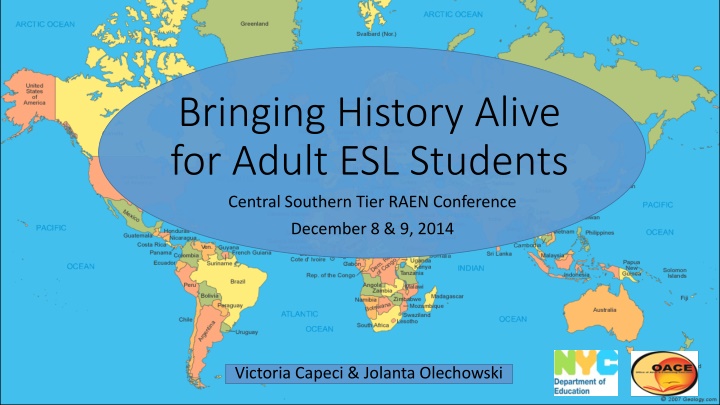
Innovative Strategies to Integrate History into ESL Classes
Explore how to enhance ESL classes with history, discussing the benefits, potential challenges, and tools needed for effective integration. Gain insights on engaging history-related activities and building context to enrich the learning experience for adult ESL students.
Uploaded on | 2 Views
Download Presentation

Please find below an Image/Link to download the presentation.
The content on the website is provided AS IS for your information and personal use only. It may not be sold, licensed, or shared on other websites without obtaining consent from the author. If you encounter any issues during the download, it is possible that the publisher has removed the file from their server.
You are allowed to download the files provided on this website for personal or commercial use, subject to the condition that they are used lawfully. All files are the property of their respective owners.
The content on the website is provided AS IS for your information and personal use only. It may not be sold, licensed, or shared on other websites without obtaining consent from the author.
E N D
Presentation Transcript
Bringing History Alive for Adult ESL Students Central Southern Tier RAEN Conference December 8 & 9, 2014 Victoria Capeci & Jolanta Olechowski
ESL & History Welcome Objectives: Explore Strategies for integrating history into ESL classes History-related materials & resources
Adult ESL Students Why History? How can integrating the study of history and English enrich our ESL classes? What kinds of history-related activities have you done in your ESL classes? What are potential pitfalls of dealing with history in ESL classes?
ESL & History Tools of the Trade The basics students need to explore history in English
ESL & History: Tools of the Trade When? Basic numbers Years Hundreds Game
ESL & History: Tools of the Trade Where? Words & Maps
ESL & History: Tools of the Trade Who? People and Places
ESL & History Building Context Colonies and Independence
So France was in Africa, Spain was in South America, and England was all over the place. Why? Why did colonists go to other countries? $$$ Religion Freedom The who who, where where, and when when help students navigate the why why.
ESL & History Building Context Colonies and Independence Why assign countries? Students all from one country Weaker English language skills Expose students to a variety of countries
ESL & History Building Context One size does not fit all. Activities need to be tweaked according to students general education level English language skills: reading, writing, speaking, listening Every class is different
ESL & History Building Context Colonies and Independence Take 2: Class Independence Timeline The Class Core group with strong listening/speaking skills Almost everyone: emerging readers & writers, very limited formal ed. A few students with very weak speaking & listening skills A nurse from Brazil Worldly
ESL & History Building Context Class Independence Timeline It gets messy . Open-ended questions don t have a single, definitive answer Students disagree on dates Students are unsure about their own country s history Concept of civil war vs. war of independence Date independence declared or recognized (Brazil: declared in 1822, recognized by Portugal in1825) Territory vs colony (Puerto Rico) Some countries gained independence more than once, from more than one country (Dom. Republic: Spain 1821 & Haiti 1844)
ESL & History Building Context Class Independence Timeline It gets messy, but that s a good thing. Resolving ambiguity gives students lots of language practice. Messy issues engage students in meaningful conversations. Accustom students to the idea of point of view. Generate interesting questions for follow-up. Community building: Students solve problems together and learn about each other. Note: Just be sure to keep the conversations going in English.
ESL & History Textbook History Geography Civics Citizenship Test
ESL & History Navigating Text Civics (History and Government) Questions for the Naturalization Test Primary and Secondary Sources
ESL & History: Negotiating Text There are words . apple flower and words constitution emancipation slavery colonists Need Need context context and and background knowledge background knowledge to navigate to navigate abstract abstract, , academic academic vocabulary vocabulary
ESL & History Navigating Text Chapter Three: 13 Colonies Chapter Three: 13 Colonies (Page 36) Take a look. What do you notice? Textbook has just a few pages per major period in U.S. history Not much text on the page, but it s abstract Deceptive: Just because it s a literacy-level text doesn t mean you re ready to roll It s important to unpack even a literacy-level ESL text.
ESL & History Active Reading Chapter Three 13 Colonies Page 36
ESL & History Extension: Making Connections Citizenship: The 100 Questions Q. What do we know about The 100 Questions? A. They read like a phone book.
ESL & History Extension: Making Connections Citizenship: The 100 Questions American History Colonial Period and Independence 58. What is one reason colonists came to America? (This is the first question in the section on American history.)
ESL & History Extension: Making Connections Citizenship: The 100 Questions American History Colonial Period and Independence 58. What is one reason colonists came to America? freedom political liberty religious freedom economic opportunity practice their religion escape persecution
ESL & History How can we help our adult students experience history is accessible, interesting, and useful? Know your students: plan accordingly Scope: break it down, smaller chunks, dig deeper Background knowledge: capitalize on the students life experiences Concrete to abstract: provide students with navigation tools Plenty of time to grapple with the material, repetition is good Make it fun: give students a chance to interact and communicate with each other
